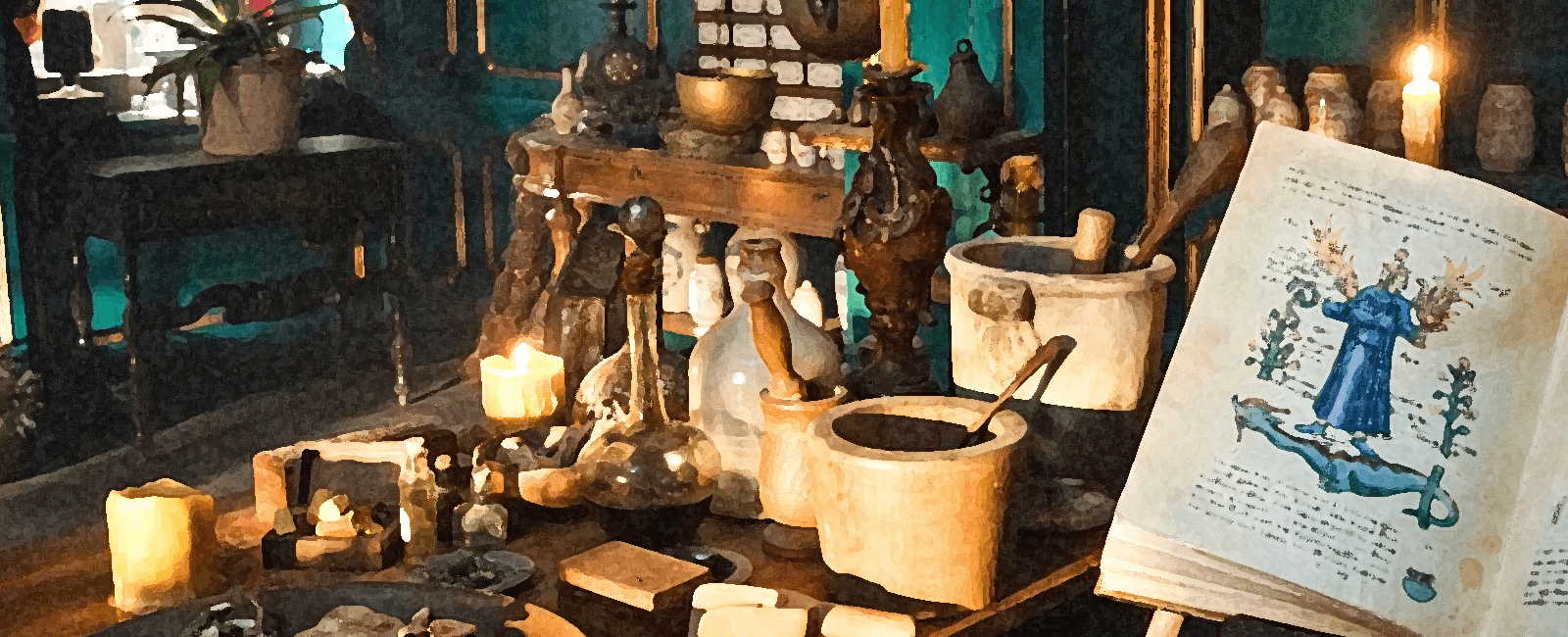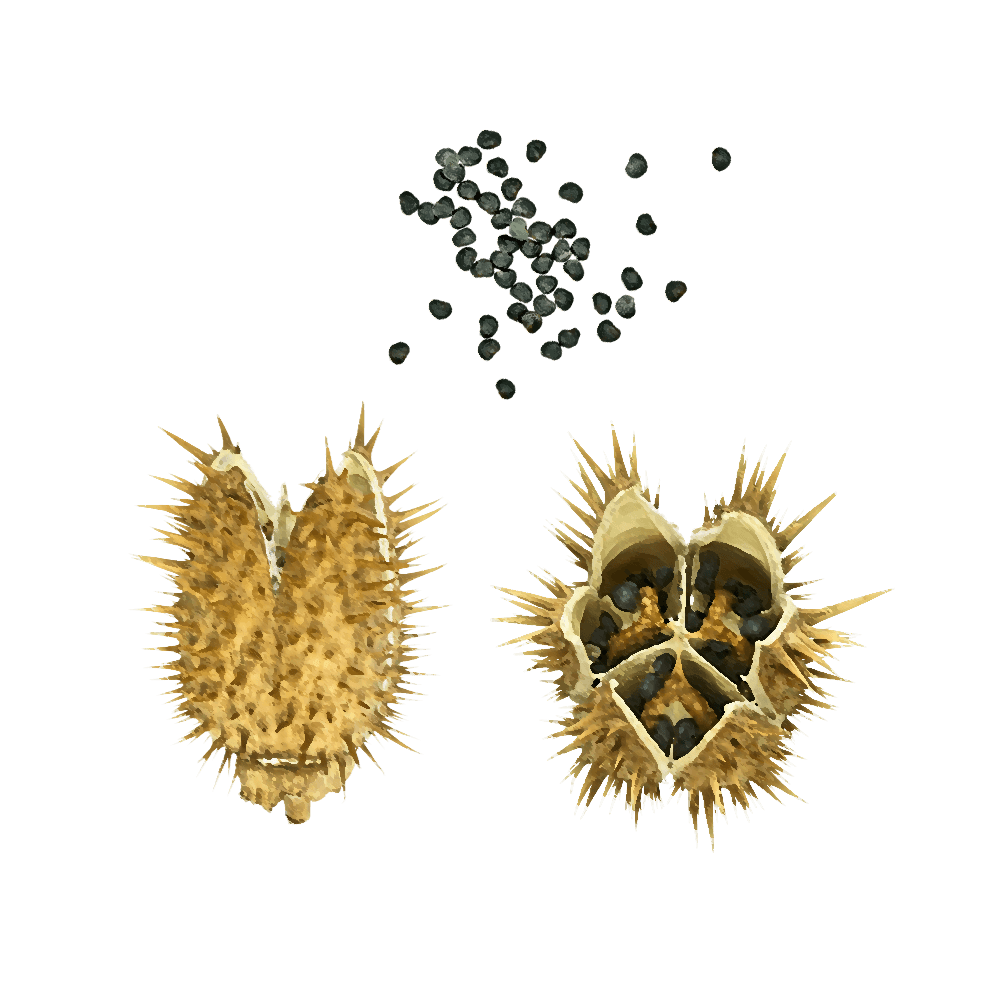Sand Snare
Sand snares are a flora species endemic to the eastern parts of the The Shifting Desert. The plant is famous for its unique predatory behaviors and its usefulness in medicine.
Basic Information
Anatomy
Sand snare have an oval shape, with long and hardened thorns sticking out. The outer shell is often brown, although yellow variations can also be found. Regardless of exterior color, the fruit has a creamy white coating on the inside. It is divided into 3 chambers somewhat equal in size, each contains a brown membrane that holds between 5 to 10 small black seeds. The seeds themselves vary slightly in color and size and can be anywhere between 0.3 to 0.7 inches (1-2 centimeters) in length and up to 0.3 inches (1 centimeter) in width.
The underline root system, known as a "colony", is shaped like a wide bowl, brown in color and can reach a radius of up to a mile (1.6 kilometer). The fruits themselves will grow on the outer perimeter of the root system, feeding a core that is buried up to 100 feet (~30 meters) under the sand and can weight up to a 2000 lbs (~900 kilograms).
Growth Rate & Stages
A fully grown cluster can take centuries to mature to its full potential. The core is the oldest part, born from seeds that fall to the sand as the plant hunts for prey. The seeds can remain dormant for up to a month and must receive water before they can sprout roots, making reproduction extremely hard to document. It is believed that the initial roots are able of small movements and are used to push the seed as far as possible from it's mother colony.
Over a decade, the seed slowly turns into a new core, a mass of intertwined roots that can reach weights of 600 lbs (~270 kg) and sometimes more. Once the core reaches a sufficient size, it starts spreading roots outwards, slowly curling upwards the farther they go. If roots of two different plants cross paths, the two plants will imminently act to animate the other, consuming the other's core and taking over the existing root system, enriching their own.
This conflict, while extremely rare, can be heard and seen from miles. Roots up to half a mile long clash with intense violence, hammering at each other while the cores race underground towards one another. This movement creates massive, turbulent dust clouds that are capable of producing small thunder storms while on their rampage. The ground itself also quake and the tremors, depending on the terrain, can be felt from more than 10 miles away.
Once a colony reach about a mile in diameter it begins to sprout. The "flower" is a small bead with 5 razor sharp barbs that emerge from the end points of the roots, 3-5 feet (~1 meter) below ground. The flower then turns into a fruit that is covered in hardened sharp barbs. The exact use of barbs is yet to be determined, as they play no part in the plant's predatory tactics or provide any sort of defense against its only natural predator, the Sand Camel.
The fruits themselves may live for up to 50 years each and once they are ripe they will naturally fall off and die while another slowly take their place. Once a fruit has fallen it ripens quickly, releasing strong toxins that are harmful when inhaled or digested, with the contents of a single fruit enough to put a single person into a coma.
It is unknown how old sand snares can age, with several colonies known to exists for several centuries. Some scholars suggest the plant is actually immortal, and only dies due to diseases or other traumas.
Ecology and Habitats
Unlike most local plants, yet similar to most fauna species that are endemic to the region, sand snares migrate slowly over time. As the colony grows it moves with the sands of the desert, slowly spiraling away from its original colony, it will collide and entangle with other colonies. Such encounters can be felt through the ground in the form of small tremors and shakes as both colonies try to choke and rip the other apart using the vast root systems. The victor will usually consume the losing opponent, slowly merging with its roots while also consuming the central core.
Dietary Needs and Habits
Perhaps the most interesting attribute of the plant is its dietary habits. The plant is strictly carnivorous, with an incredibly smart hunting mechanism. When the plant senses a large number of vertebrates, such as small mammals and reptiles inside it's diameter, the core starts to pulse and shake, sending tremors to the ground above.
The shakes scare the animals to flee away from the core, only to run straight towards the plant's fruits that spring from the ground, opening up their shells to catch the fleeing prey. Once the fruit locks its hardened shell on a prey the seeds erupts, releasing a powerful sedative that puts the prey into a deep coma as it is being dragged under the sands, choking to death while still unconscious.
Additional Information
Domestication
While not really domesticated, both the Sala'kir and the Makai make use of the plant. The Sala'kir are known to use them for pest control, often intentionally herding them with sand camels to settle under their dwellings. Rats, snakes, scorpions and other harmful creatures are then quickly eliminated from the area, living their food storage safe.
The Makai use the plant as a form of alarm against other tribes who might prey upon them. When they travel they would often "kite" several plant using small animals such as rats or other available small creatures. The plants sends a small tremor to the core each time something is crossing over it. Those small tremors can be detected by specialized listeners, stationed above each core, to listen and feel the core's movement with a specialized hollowed horn. This allows the traveling group to know the movement of others and avoid slavers, bandits and other dangers.
Uses, Products & Exploitation
One of the most famous byproducts of the sand snare is the plant's seeds. Used as a strong sedative, key ingredients in powerful poisons and as an important medicine produce.
Ingesting the seeds on their own is known to induce an almost immediate coma in a grown adult that can last up to four hours. Both the Sala'kir and the Makai use it for both recreational and shamanistic purposes.
The seeds can also be extracted for oil, which after farther refinement becomes a clear, odorless chemical with a slightly oily texture. The oil is far more potent and is used in medicine to sedate patients before difficult operations. Other common use of the oil is both in poisons and in narcotics, usually in very small doses to act as a chemical agent and amplifier.
The oil is somewhat sensitive to light, quickly losing its properties if subjected to direct sunlight. It also evaporates quickly unless stored in hermetic containers. Those limitations, as well as the need to "bait" the fruit out of the ground for its seeds, often with great risk for poisoning, make the seeds and their byproducts incredibly hard and expensive for outsiders.
Current Date: 2nd of Latsum, 1572
Scientific Name
Citrullus Sepelione
Lifespan
Fruit: ~50 years
Colony: Unknown (centuries, presumed immortality)
Colony: Unknown (centuries, presumed immortality)
Average Height
Fruit: 7.8 inches (~20 cm)
Core: 6 feet (~2 m)
Colony: 80 feet (~25 m)
Core: 6 feet (~2 m)
Colony: 80 feet (~25 m)
Average Weight
Fruit: 4 lbs (1.8 kg)
Core: 2,000 lbs (~900 kg)
Colony: 6,000 lbs (~2,700 kg)
Core: 2,000 lbs (~900 kg)
Colony: 6,000 lbs (~2,700 kg)
Average Length
Fruit: 3.9 inches (~10 cm)
Core: 6 feet (~2 m)
Colony: 1 mile (~1.6 km)
Core: 6 feet (~2 m)
Colony: 1 mile (~1.6 km)
Geographic Distribution




Comments